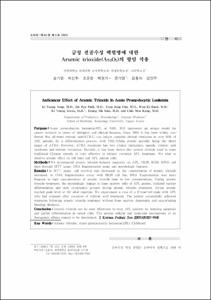급성 전골수성 백혈병에 대한 Arsenic trioxide(As2O3)의 항암 작용
- Keimyung Author(s)
- Baek, Won Ki; Kwon, Ki Young; Kim, Heung Sik; Kang, Chin Moo
- Journal Title
- 소아과
- Issued Date
- 2000
- Volume
- 43
- Issue
- 3
- Abstract
- Purpose : Acute promyelocytic leukemia(APL or AML, M3) represents an unique model for cancer research in terms of biological and clinical features. Since 1988, it has been widely confirmed that all-trans retinoic acid(ATRA) can induce complete clinical remission in over 85% of APL patients by a differentiation process, with PML-RARα protein possibly being the direct target of ATRA. However, ATRA treatment has two clinical limitations, namely, retinoic acid syndrome and retinoic resistance. Recently, it has been shown that arsenic trioxide used in some traditional Chinese remedy is very effective in retinoic resistant APL treatment. We tried to observe arsenic effect on cell lines and APL patient cells. Methods : We investigated arsenic trioxide-induced apoptosis on APL, HL60, K562, KPH1 cell lines through MTT assay, DNA fragmentation assay and morphologic features. Results : In MTT assay, cell survival rate decreased as the concentration of arsenic trioxide increased. In DNA fragmentation assay with HL60 cell line, DNA fragmentation was more frequent in high concentrations of arsenic trioxide than in low concentrations. During arsenic trioxide treatment, the morphologic change in bone marrow cells of APL patient, included nuclear differentiation and dark cytoplasmic granule during arsenic trioxide treatment. Serum arsenic reached peak level at 4hr after injection. We experienced a case of a 9-year-old male with APL who had relapsed after cessation of retinoic acid treatment. The patient successfully achieved remission following arsenic trioxide treatment without bone marrow depression and exacerbating bleeding diathesis. Conclusion : Arsenic trioxide can be used effectively to treat APL patients by inducing apoptosis and partial differentiation in tumor cells. The precise cellular and molecular mechanisms of its therapeutic effects remain to be determined.
- Alternative Title
- Anticancer Effect of Arsenic Triowide in Acute Promyelocytic Leukemia
- Publisher
- School of Medicine
- Citation
- 송기영 et al. (2000). 급성 전골수성 백혈병에 대한 Arsenic trioxide(As2O3)의 항암 작용. 소아과, 43(3), 327–334.
- Type
- Article
- ISSN
- 0560-3560
- 파일 목록
-
-
Download
 oak-bbb-4533.pdf
기타 데이터 / 397.01 kB / Adobe PDF
oak-bbb-4533.pdf
기타 데이터 / 397.01 kB / Adobe PDF
-
Items in Repository are protected by copyright, with all rights reserved, unless otherwise indicated.